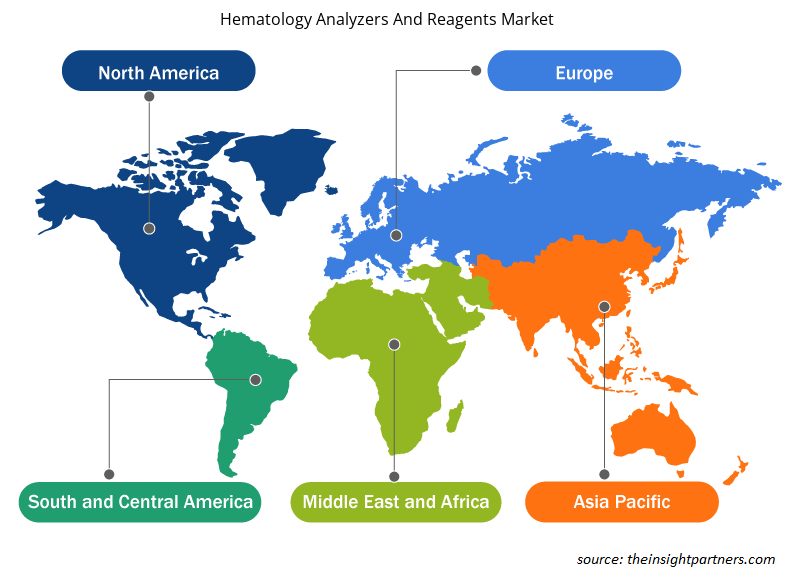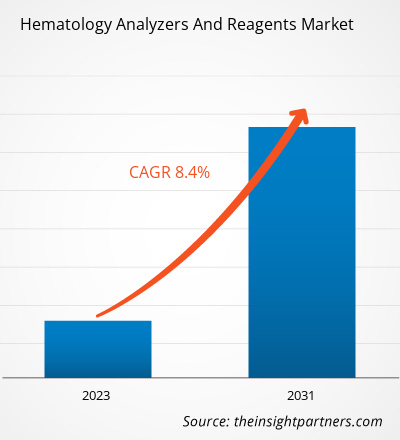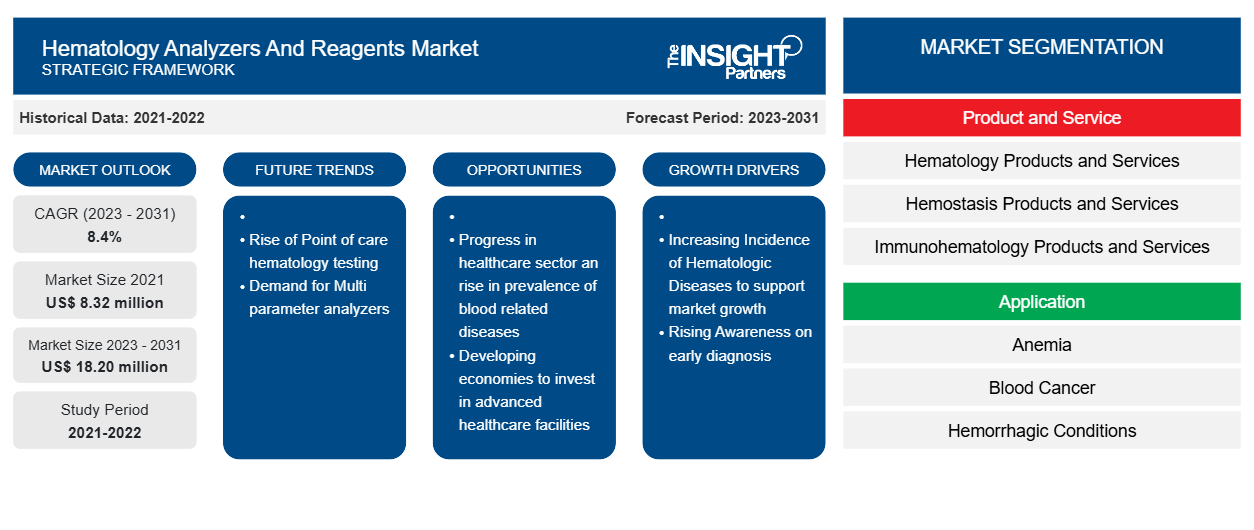Se estimó que el tamaño del mercado de analizadores y reactivos de hematología sería de US$ 8,32 millones en 2021 y US$ XX millones en 2023 y se espera que alcance los US$ 18,20 millones para 2031; se estima que registrará una CAGR del 8,4% hasta 2031. Es probable que la creciente adopción de dispositivos inteligentes en el punto de atención siga siendo una tendencia clave en el mercado de analizadores y reactivos de hematología.
Análisis de mercado de ANALIZADORES Y REACTIVOS PARA HEMATOLOGÍA
Los actores que operan en el mercado de analizadores y reactivos hematológicos son altamente competitivos y han estado introduciendo nuevos productos y reactivos. Por ejemplo, en enero de 2024, HORIBA Medical lanzó la última plataforma de hematología automatizada de alto rendimiento HELO 2.0. La plataforma está aprobada por la CE (Reglamento Europeo de Dispositivos de Diagnóstico In Vitro) y actualmente está a la espera de la aprobación de la Administración de Alimentos y Medicamentos de EE. UU. (FDA). HELO 2.0 es la próxima generación de la gama de hematología de alta gama y se ha desarrollado en consulta con los clientes para satisfacer todas las necesidades de hematología totalmente automatizada de alto rendimiento. HELO 2.0 ofrece una solución de hematología modular altamente flexible y eficiente, que se puede escalar y configurar por completo para adaptarse a las diferentes necesidades de los laboratorios de mediana y gran escala. De manera similar, en mayo de 2023, Siemens Healthineers lanzó dos soluciones para pruebas hematológicas de alto volumen: el analizador Atellica HEMA 570 y el analizador Atellica HEMA 580. La capacidad del laboratorio para revisar y publicar rápidamente los resultados de las pruebas de los pacientes se ve obstaculizada por el uso generalizado de las pruebas de hemograma completo y la creciente escasez de personal. Los analizadores Atellica HEMA 570 y Atellica HEMA 580 ofrecen automatización e inteligencia integradas para mejorar la eficiencia del flujo de trabajo y producir resultados de los pacientes más rápido. Los lanzamientos de estos nuevos productos están impulsando el crecimiento del mercado de analizadores y reactivos hematológicos.
Descripción general del mercado de ANALIZADORES Y REACTIVOS PARA HEMATOLOGÍA
El crecimiento del mercado de analizadores y reactivos hematológicos se atribuye al aumento de la cantidad de enfermedades hematológicas y a los avances tecnológicos en analizadores hematológicos. Sin embargo, los altos precios de los sistemas de alta gama probablemente estén obstaculizando el crecimiento del mercado.
El mercado global de analizadores y reactivos hematológicos está segmentado por región en América del Norte, Europa, Asia Pacífico, Oriente Medio y África, y América del Sur y Central. La región de América del Norte es el mayor accionista y Asia Pacífico es el mercado de más rápido crecimiento para analizadores y reactivos hematológicos. Se estima que el crecimiento del mercado de analizadores y reactivos hematológicos tendrá una mayor participación en los EE. UU. Se espera que el crecimiento del mercado en los EE. UU. aumente debido a un número creciente de procedimientos de análisis de sangre, una alta prevalencia de enfermedades hematológicas, un número creciente de centros de diagnóstico y análisis de sangre y acceso a una infraestructura bien desarrollada, entre otros.
Personalice este informe según sus necesidades
Obtendrá personalización en cualquier informe, sin cargo, incluidas partes de este informe o análisis a nivel de país, paquete de datos de Excel, así como también grandes ofertas y descuentos para empresas emergentes y universidades.
-
Obtenga las principales tendencias clave del mercado de este informe.Esta muestra GRATUITA incluirá análisis de datos, desde tendencias del mercado hasta estimaciones y pronósticos.
ANALIZADORES Y REACTIVOS DE HEMATOLOGÍA Impulsores del mercado y oportunidades
Aumento de la incidencia de enfermedades hematológicas favorece al mercado
Según los Centros para el Control y la Prevención de Enfermedades (CDC), aproximadamente 12 de cada 100.000 varones y 400 niños en los EE. UU. nacen con hemofilia A cada año. Además, la Sociedad de Leucemia y Linfoma (LLS) informa que en los EE. UU., una persona es diagnosticada con linfoma, leucemia o mieloma cada 3 minutos. En 2023, se estima que un total de 184.720 personas en los EE. UU. serán diagnosticadas con leucemia, linfoma o mieloma. Además, se espera que los nuevos casos de linfoma, leucemia y mieloma representen el 9,4% de los 1.958.310 nuevos casos de cáncer que se diagnosticarán en los EE. UU. en 2023. La creciente prevalencia de enfermedades hematológicas aumenta las demandas de transfusiones de sangre, así como el recuento de células sanguíneas para controlar la normalidad, lo que aumenta aún más la demanda de analizadores y reactivos hematológicos. La creciente incidencia de enfermedades relacionadas con la sangre está aumentando el crecimiento del mercado de analizadores y reactivos hematológicos.
Progreso en los sectores de la salud y aumento de la prevalencia de enfermedades relacionadas con la sangre en las economías emergentes: una oportunidad en el mercado de analizadores y reactivos hematológicos
La incidencia de enfermedades hematológicas está aumentando significativamente en los países en desarrollo debido al cambio en el estilo de vida de las poblaciones. Además, la creciente prevalencia de otras afecciones de salud debido a la disminución de las actividades físicas y el aumento de los niveles de estrés también está contribuyendo al aumento de los casos de trastornos hematológicos en estos países. Las naciones en desarrollo se esfuerzan por lograr avances significativos en sus instalaciones y servicios de atención médica. Por ejemplo, la Federación de Hemofilia de la India (HFI) es una organización sin fines de lucro que ha trabajado en estrecha colaboración con la Federación Mundial de Hemofilia (FMH) para aumentar la conciencia sobre la hemofilia y los tratamientos asequibles disponibles para la misma, así como para mejorar el diagnóstico de la enfermedad. Además, el equipo profesional de RED LAPI se esfuerza por contribuir y mejorar el diagnóstico y el tratamiento de la hemofilia en América Latina. Estos avances en el mercado de analizadores y reactivos hematológicos en las naciones en desarrollo de Asia Pacífico, Oriente Medio y África, y América Latina están brindando oportunidades para el crecimiento futuro de los actores del mercado.
Análisis de segmentación del informe de mercado de ANALIZADORES Y REACTIVOS DE HEMATOLOGÍA
Los segmentos clave que contribuyeron a la derivación del análisis del mercado de analizadores y reactivos de hematología son producto y servicio, causa, aplicación y usuario final.
- Según el producto y el servicio, el mercado de analizadores y reactivos de hematología se segmenta en productos y servicios de hematología, productos y servicios de hemostasia y productos y servicios de inmunohematología. Los productos y servicios de hematología se subsegmentan además como instrumentos, reactivos y consumibles, y servicios. De manera similar, el segmento de productos y servicios de hemostasia se segmenta además en instrumentos, reactivos y consumibles, y servicios. El segmento de productos y servicios de inmunohematología del mercado de analizadores y reactivos de hematología también se segmenta aún más en instrumentos, reactivos y consumibles, y servicios. El segmento de productos y servicios de hematología tuvo una mayor participación de mercado en 2023.
- Por aplicación, el mercado está segmentado en anemia, cáncer de sangre, afecciones hemorrágicas, afecciones relacionadas con infecciones, afecciones relacionadas con el sistema inmunológico y otras aplicaciones. El segmento de anemia tuvo la mayor participación del mercado en 2023.
- En términos de usuario final, el mercado está segmentado en laboratorios hospitalarios, proveedores de servicios comerciales, laboratorios de referencia gubernamentales e institutos de investigación y académicos. El segmento de laboratorios hospitalarios dominó el mercado en 2023.
Análisis de la cuota de mercado de los analizadores y reactivos hematológicos por geografía
El alcance geográfico del informe de mercado de analizadores y reactivos de hematología se divide principalmente en cinco regiones: América del Norte, Asia Pacífico, Europa, Medio Oriente y África, y América del Sur / América del Sur y Central.
En América del Norte, Estados Unidos es el mayor mercado de fabricación de analizadores y reactivos hematológicos. El crecimiento del mercado estadounidense se debe principalmente a escenarios de investigación favorables, una creciente demanda de sangre y componentes sanguíneos y una alta adopción de instrumentos hematológicos automatizados.
Prevalencia creciente de trastornos hematológicos como leucemia, hemofilia y anemia en los EE. UU. Las estimaciones de la Sociedad Estadounidense del Cáncer para la leucemia en los EE. UU. para 2024 son:
- Aproximadamente 62.770 nuevos casos de leucemia (de todo tipo) y 23.670 muertes por leucemia (de todo tipo)
- Se detectaron aproximadamente 20.800 nuevos casos de leucemia mieloide aguda (LMA). La mayoría de ellos se darán en adultos.
- Aproximadamente 11.220 muertes por leucemia mieloide aguda. Casi todas serán adultos.
Se espera que la creciente concienciación sobre el diagnóstico temprano entre los pacientes sea una de las principales fuerzas impulsoras del mercado de analizadores y reactivos hematológicos. Se prevé que Asia Pacífico crezca con la CAGR más alta en los próximos años.
Perspectivas regionales del mercado de analizadores y reactivos hematológicos
Los analistas de Insight Partners explicaron en detalle las tendencias y los factores regionales que influyen en el mercado de analizadores y reactivos hematológicos durante el período de pronóstico. Esta sección también analiza los segmentos y la geografía del mercado de analizadores y reactivos hematológicos en América del Norte, Europa, Asia Pacífico, Oriente Medio y África, y América del Sur y Central.

- Obtenga datos regionales específicos para el mercado de analizadores y reactivos hematológicos
Alcance del informe de mercado de analizadores y reactivos hematológicos
| Atributo del informe | Detalles |
|---|---|
| Tamaño del mercado en 2021 | US$ 8,32 millones |
| Tamaño del mercado en 2031 | US$ 18,20 millones |
| CAGR global (2023 - 2031) | 8,4% |
| Datos históricos | 2021-2022 |
| Período de pronóstico | 2023-2031 |
| Segmentos cubiertos |
Por producto y servicio
|
| Regiones y países cubiertos |
América del norte
|
| Líderes del mercado y perfiles de empresas clave |
|
Densidad de actores del mercado de analizadores y reactivos hematológicos: comprensión de su impacto en la dinámica empresarial
El mercado de analizadores y reactivos hematológicos está creciendo rápidamente, impulsado por la creciente demanda de los usuarios finales debido a factores como la evolución de las preferencias de los consumidores, los avances tecnológicos y una mayor conciencia de los beneficios del producto. A medida que aumenta la demanda, las empresas amplían sus ofertas, innovan para satisfacer las necesidades de los consumidores y aprovechan las tendencias emergentes, lo que impulsa aún más el crecimiento del mercado.
La densidad de actores del mercado se refiere a la distribución de las empresas o firmas que operan dentro de un mercado o industria en particular. Indica cuántos competidores (actores del mercado) están presentes en un espacio de mercado determinado en relación con su tamaño o valor total de mercado.
Las principales empresas que operan en el mercado de analizadores y reactivos hematológicos son:
- Soluciones de diagnóstico clínico, Inc.
- Shenzhen Mindray Electrónica Biomédica Co., Ltd.
- Danaher
- LABORATORIOS BIO-RAD INC.
- Abad
- Diatrón
Descargo de responsabilidad : Las empresas enumeradas anteriormente no están clasificadas en ningún orden particular.

- Obtenga una descripción general de los principales actores clave del mercado de analizadores y reactivos hematológicos
Noticias y desarrollos recientes del mercado de analizadores y reactivos hematológicos
El mercado de analizadores y reactivos hematológicos se evalúa mediante la recopilación de datos cualitativos y cuantitativos posteriores a la investigación primaria y secundaria, que incluye publicaciones corporativas importantes, datos de asociaciones y bases de datos. A continuación, se incluye una lista de los avances en el mercado de analizadores y reactivos hematológicos y las estrategias:
- HORIBA Medical ha lanzado nuevos productos en su familia de productos de hematología Yumizen. La empresa presentó dos analizadores hematológicos de sobremesa compactos, Yumizen H500 y Yumizen H550, que ofrecen un rendimiento mejorado, nuevas funciones y mayores beneficios. Estos analizadores han sido diseñados para ofrecer un informe hematológico rápido y completo con un alto rendimiento de 60 pruebas por hora, autonomía de 40 tubos con carga continua, modo manual urgente y modos de análisis múltiple y muestreo para muestras en ejecución. (Fuente: HORIBA Medical, 2022)
- Mindray lanzó una revolucionaria serie de analizadores hematológicos, la serie BC-700, que incorpora pruebas de hemograma completo (CSC) y velocidad de sedimentación globular (VSG). La serie incluye dos modelos de vial abierto, BC-700/BC-720, y dos modelos con cargador automático, BC-760/BC-780. Esta serie está diseñada para dotar a los laboratorios de volumen medio de tecnologías de diagnóstico avanzadas aplicadas en productos de primera calidad. (Fuente: Shenzhen Mindray Bio-Medical Electronics Co., Ltd., comunicado de prensa, 2022)
Informe de mercado de analizadores y reactivos hematológicos: cobertura y resultados
El informe “Tamaño y pronóstico del mercado de analizadores y reactivos hematológicos (2021-2031)” proporciona un análisis detallado del mercado que cubre las siguientes áreas:
- Tamaño del mercado y pronóstico a nivel global, regional y nacional para todos los segmentos clave del mercado cubiertos bajo el alcance
- Dinámica del mercado, como impulsores, restricciones y oportunidades clave
- Principales tendencias futuras
- Análisis detallado de las cinco fuerzas de Porter y PEST y FODA
- Análisis del mercado global y regional que cubre las tendencias clave del mercado, los principales actores, las regulaciones y los desarrollos recientes del mercado.
- Análisis del panorama de la industria y de la competencia que abarca la concentración del mercado, el análisis de mapas de calor, los actores destacados y los desarrollos recientes
- Perfiles detallados de empresas
- Análisis histórico (2 años), año base, pronóstico (7 años) con CAGR
- Análisis PEST y FODA
- Tamaño del mercado, valor/volumen: global, regional y nacional
- Industria y panorama competitivo
- Conjunto de datos de Excel
Informes recientes
Testimonios
Razón para comprar
- Toma de decisiones informada
- Comprensión de la dinámica del mercado
- Análisis competitivo
- Información sobre clientes
- Pronósticos del mercado
- Mitigación de riesgos
- Planificación estratégica
- Justificación de la inversión
- Identificación de mercados emergentes
- Mejora de las estrategias de marketing
- Impulso de la eficiencia operativa
- Alineación con las tendencias regulatorias























 Obtenga una muestra gratuita para - Mercado de analizadores y reactivos hematológicos
Obtenga una muestra gratuita para - Mercado de analizadores y reactivos hematológicos